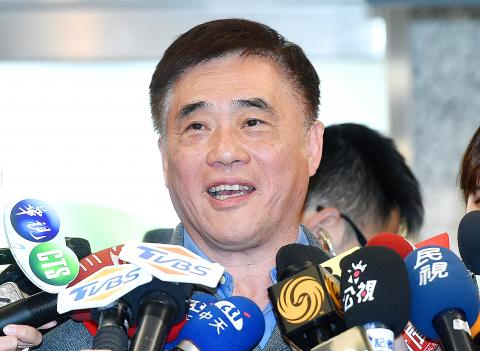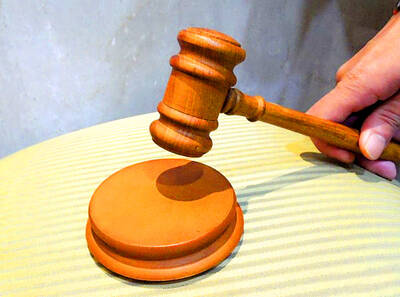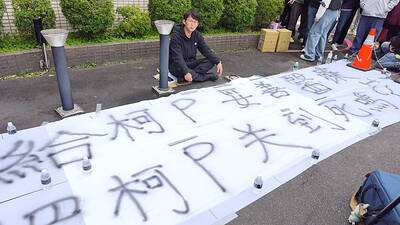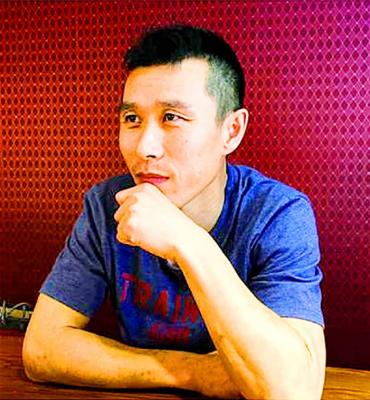Former Chinese Nationalist Party (KMT) vice chairman Hau Lung-bin (郝龍斌), who on Monday evening announced his bid for KMT chairperson, yesterday said that the party must come to a new consensus on its cross-strait stance, as the ruling Democratic Progressive Party (DPP) and the Chinese Communist Party (CCP) “have collaborated to destroy” the Republic of China (ROC).
Hau stepped down along with former KMT chairman Wu Den-yih (吳敦義) on Wednesday last week, following the party’s defeats in the Jan. 11 presidential and legislative elections. He launched his bid via Facebook on Monday.
Hau is the third person to commit to joining the KMT’s March 7 chairperson by-election, following National Taiwan University political science professor Chang Ya-chung (張亞中) and Blue Sky Action Alliance convener Wu Chih-chang (武之璋).

Photo: Liao Chen-huei, Taipei Times
If elected chairman, he would be committed to helping the KMT overcome its “unprecedented crisis” and fostering young talent in the party, Hau wrote on Facebook.
To ensure the party is in touch with public opinion and to encourage more young members to participate, he would promote new regulations to guarantee the party’s elected officials meet certain quotas, and that there are members aged 40 and younger in the KMT Central Committee and Central Standing Committee, he said.
He would also promote internal dialogue to develop a cross-strait policy for the party, he said.
During an interview with radio station News98 yesterday, Hau said that one reason the KMT lost the elections was because “the DPP and CCP have collaborated to destroy the ROC.”
While the DPP rejects the “1992 consensus” and even interprets it as supporting Beijing’s “one country, two systems” formula, the CCP refuses to acknowledge the existence of the ROC or the consensus’ perquisite of “one China, with each side having its own interpretation of what China means,” he said.
Although the “1992 consensus” worked well for both sides of the Strait from 2008 to 2016, currently “there is no consensus between the KMT and the CCP,” he said.
If the KMT cannot develop a new cross-strait policy that is acceptable to the public and the other side of the Taiwan Strait, “the KMT’s development would be limited,” he said.
Asked for comment, KMT Legislator Chiang Wan-an (蔣萬安), who has been described by some political watchers as a political star of the KMT’s middle generation, said he looks forward to the reform plans of any party member who is willing to shoulder the responsibility of party chairperson.
As a KMT member, he would seek to assist the party in the reforms that follow, he added.
Separately yesterday, KMT Central Committee member Sean Lien (連勝文) told Pop Radio that he has received 200 to 300 text messages from friends urging him to run for KMT chairperson.
However, even if he decides to launch a bid, as an individual he would not be able shoulder all responsibility for leading the KMT, he said.
The party needs collective leadership, he said, adding that, more importantly, members must avoid conflicts of interest.
Some members run for chairperson because they want to run for president and end up tearing the party apart, he said.
Many Central Standing Committee members spend their time fawning over the upper management with the hope of obtaining a legislator-at-large seat, he added.
The so-called “1992 consensus,” a term former Mainland Affairs Council chairman Su Chi (蘇起) in 2006 admitted making up in 2000, refers to a tacit understanding between the KMT and the Chinese government that both sides of the Strait acknowledge there is “one China,” with each side having its own interpretation of what “China” means.
Additional reporting by Wu Su-wei and Chen Yu-fu

The High Prosecutors’ Office yesterday withdrew an appeal against the acquittal of a former bank manager 22 years after his death, marking Taiwan’s first instance of prosecutors rendering posthumous justice to a wrongfully convicted defendant. Chu Ching-en (諸慶恩) — formerly a manager at the Taipei branch of BNP Paribas — was in 1999 accused by Weng Mao-chung (翁茂鍾), then-president of Chia Her Industrial Co, of forging a request for a fixed deposit of US$10 million by I-Hwa Industrial Co, a subsidiary of Chia Her, which was used as collateral. Chu was ruled not guilty in the first trial, but was found guilty

DEADLOCK: As the commission is unable to forum a quorum to review license renewal applications, the channel operators are not at fault and can air past their license date The National Communications Commission (NCC) yesterday said that the Public Television Service (PTS) and 36 other television and radio broadcasters could continue airing, despite the commission’s inability to meet a quorum to review their license renewal applications. The licenses of PTS and the other channels are set to expire between this month and June. The National Communications Commission Organization Act (國家通訊傳播委員會組織法) stipulates that the commission must meet the mandated quorum of four to hold a valid meeting. The seven-member commission currently has only three commissioners. “We have informed the channel operators of the progress we have made in reviewing their license renewal applications, and

Taiwan People’s Party (TPP) Chairman Huang Kuo-chang (黃國昌) yesterday appealed to the authorities to release former Taipei mayor Ko Wen-je (柯文哲) from pretrial detention amid conflicting reports about his health. The TPP at a news conference on Thursday said that Ko should be released to a hospital for treatment, adding that he has blood in his urine and had spells of pain and nausea followed by vomiting over the past three months. Hsieh Yen-yau (謝炎堯), a retired professor of internal medicine and Ko’s former teacher, said that Ko’s symptoms aligned with gallstones, kidney inflammation and potentially dangerous heart conditions. Ko, charged with

Taiwan-based publisher Li Yanhe (李延賀) has been sentenced to three years in prison, fined 50,000 yuan (US$6,890) in personal assets and deprived political rights for one year for “inciting secession” in China, China's Taiwan Affairs Office spokesman Chen Binhua (陳斌華) said today. The Shanghai First Intermediate People’s Court announced the verdict on Feb. 17, Chen said. The trial was conducted lawfully, and in an open and fair manner, he said, adding that the verdict has since come into legal effect. The defendant reportedly admitted guilt and would appeal within the statutory appeal period, he said, adding that the defendant and his family have